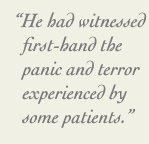|
E SUDDENLY STOPPED breathing and his face began
to turn blue. He was certain he was dying as the lights started
to dim while he struggled helplessly and gasped for breath. The
patient’s frantic physician immediately called a Code Blue…“Doctor,
Heart, Doctor, Heart!” Emergency personnel from all departments
came running from every direction of the hospital with stethoscopes
bouncing around their necks. Some were pushing the large, red crash
cart. They were at his side within seconds…the doctor had arrested!
 Taking
his own advice about the need for regular check-ups, the doctor
had spent the morning going through his annual physical examination.
His final test was a Cardiolite Stress Test. A colleague and long-time
friend was in attendance when the otherwise healthy heart surgeon
crashed and nearly burned. Taking
his own advice about the need for regular check-ups, the doctor
had spent the morning going through his annual physical examination.
His final test was a Cardiolite Stress Test. A colleague and long-time
friend was in attendance when the otherwise healthy heart surgeon
crashed and nearly burned.
Like a call going out when a police officer goes
down, a physician in a personal medical emergency brings medics
and colleagues running from every area of the hospital. Soon, there
were more than twenty-five people in blue scrubs and white lab coats
jammed into the small EKG room, all trying to be of some aid in
this emergency rescue.
The hospital chaplain was called and he in turn
put out a call to notify the surgeon’s family members. Hospital
security was called, and all of the usual wheels of protocol were
rapidly put in motion for the disastrous turn of events in what
was a routine procedure.
The surgeon’s throat had suddenly closed and
he was unable to breathe air into his collapsed lungs as he rapidly
began to suffocate. He was in shock and respiratory arrest; he was
losing consciousness, descending into a deep, black vortex. He was
frighteningly convinced of his own mortality as he wildly thrashed
around, gasping for air. The distraught staff, trying their best
to restrain the doctor, immediately began resuscitation maneuvers.
They placed IV lines into his now-purple arms and injected epinephrine,
steroids and anunophylline. An oxygen mask was placed over his nose
and mouth, but the doctor kept pulling off the mask in his panic
and confusion because of the profound hypoxia he was now experiencing.
His oxygen saturation fell from 100 to a critical low of 68. He
was two minutes away from brain damage.
Slowly, as the drugs took effect, his lungs began
to inflate, his heart rate stabilized, and he slowly…slowly
came back to life.
It was not a heart attack, but an allergic reaction
to a drug…anaphylactic shock…a reaction that can kill
just as surely as a knife cutting off oxygen to the lungs.
The surgeon had been to the other side…not
quite to the other side of life, but to the other side of medical
treatment. He had witnessed first-hand the panic and terror experienced
by some patients. He had felt the helplessness and desperation that
is known only to those who are at risk of losing their life.
Never one to have a cavalier attitude toward the
anxiety of his patients, the doctor has now developed an even greater
empathy for their suffering. Nothing will ever be routine again.
Once we have faced death and survived, nothing will ever again be
the same.
Dr. Charles Moore has recovered and is once again
in fulltime practice as the Surgical director of Cardiac Transplantation
and Cardiac Assist Devices at the CHRISTUS Transplant Institute.
Barbara Davis
CHRISTUS Transplant Institute
San Antonio, Texas
|

